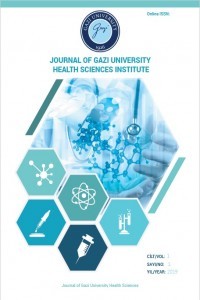Clinical and Radiological Performance of High-viscosity Glass Lonomer Cement and Compomer in Class II Restorations in Primary Molar Teeth
Clinical and Radiological Performance of High-viscosity Glass Lonomer Cement and Compomer in Class II Restorations in Primary Molar Teeth
The present study aimed to evaluate clinical and radiographical success of high viscosity glass ionomer cement and compomer in primary molar teeth for 12 months. High viscosity glass ionomer cement Equia Fil (GC Corporation, Tokyo, Japan) and compomer Dyract XP (Dentsply De Trey, Konstanz, Germany) restorations were placed in 30 children between the ages of 4 and 9 with symmetrical proximal surface caries in primary molars. Restorations were evaluated clinically according to the modified United States Public Health Service (USPHS) criteria at the 1-week, 3-month, 6-month, 12-month recall and radiographically at 6 and 12 months. When the restorations are evaluated in terms of marginal discoloration, marginal adaptation, postoperative sensitivity, secondary caries, anatomical form and radiographic findings, no statistically significant difference was observed between two groups. There was a statistically significant difference between the groups for the retention, color match and surface texture scores at 12 months. It has been concluded that retention, surface texture and color match results of Equia Fil showed less successful at the end of 12 months. Therefore, selection of samples with small cavities for Equia Fil can increase the success rate of the restoration. Further research is required to confirm the results.
Keywords:
compomer, Equia Fil glass ionomer cement, primary teeth restoration,
___
- Burke, F.J.T. & Bardha, J.S. (2013). A retrospective, practice-based, clinical evaluation of Fuji IX restorations aged over five years placed in load-bearing cavities. British Dental Journal, 215 (6), 1-5.
- Çelik, Ç., Arhun, N. & Yamanel, K. (2014). Clinical Evaluation of Resin-Based Composites in Posterior Restorations: A 3-Year Study. Medical Principles and Practice, 23 (5), 453–459.
- Daou, M.H., Attin, T. & Göhring, T.N. (2009). Clinical Success of Compomer and Amalgam Restorations in Primary Molars. Schweiz Monatsschr Zahnmed, 119 (11), 1082–1088.
- De Amorim, R.G., Leal, S.C., Mulder, J., Creugers, N.J. & Frencken, J.E. (2014). Amalgam and ART restorations in children: a controlled clinical trial. Clin Oral Investig, 18 (1), 117–124.
- Demirci, M., Yıldız, E. & Uysal, Ö. (2008). Comparative Clinical Evaluation of Different Treatment Approaches Using a Microfilled Resin Composite and a Compomer in Class III Cavities: Two-year Results. Operative Dentistry, 33 (1), 7-14.
- Extrand, K.R., Ricketts, D.N.J. & Kidd, E.A.M. (1997). Reproducibility and accuracy of three methods for assessment of demineralization depth on the occlusal surface: An in vitro examination. Caries Research, 31 (3), 224-231.
- Forsten, L. (1998). Fluoride release and uptake by glass ionomers and related materials and its clinical effect. Biomaterials, 19 (6), 503-508.
- Gurgan, S., Kutuk, Z.B., Yalcin, Cakir F. & Ergin, E. (2020). A randomized controlled 10 years follow up of a glass ionomer restorative material in class I and class II cavities. Journal of Dentistry, 94, 1-8.
- Hilgert, L.A., de Amorim, R.G., Leal, S.C., Mulder, J., Creugers, N.J. & Frencken, J.E. (2014). Is high-viscosity glass-ionomer-cement a successor to amalgam for treating primary molars? Dental Materials, 30 (10), 1172-1178.
- Kupietzky, A., Atia Joachim, D., Tal, E. & Moskovitz, M. (2019). Long-term clinical performance of heat-cured high-viscosity glass ionomer class II restorations versus resin-based composites in primary molars: a randomized comparison trial. European Archives of Pediatric Dentistry, 20 (5), 451-456.
- Markovic, D. & Peric, T. (2008). Clinical evaluation of glass-ionomer tunnel restorations in primary molars: 36 months results. Australian Dental Journal, 53, 41–45.
- Nicholson, J.W. (2007). Polyacid-modified composite resins (“compomers”) and their use in clinical dentistry. Dental Materials, 23 (5), 615–622.
- Papagiannoulis, L., Kakaboura, A., Pantaleon, F. & Kavvadia, K. (1999). Clinical evaluation of a polyacid-modified resin composite (compomer) in class II restoration of a primary teeth: a two year follow-up study. Pediatric Dentistry, 21 (4), 231–234.
- Peters, T., Roeters, J. & Frankenmolen, F. (1996). Clinical evaluation of Dyract in primary molars: 1-year results. American Journal of Dentistry, 9 (2), 83-88.
- Qvist, V., Poulsen, A., Teglers, P.T. & Mjor I.A. (2010). The longevity of different restorations in primary teeth. International Journal of Paediatric Dentistry, 20 (1), 1-7.
- Rutar, J., McAllan, L. & Tyas, M.J. (2000). Clinical evaluation of a glass ionomer cement in primary molars. Pediatric Dentistry, 22 (6), 486-488.
- Scholtanus, J.D. & Huysmans, M.C.D.N.J.M. (2007). Clinical failure of class-II restorations of a highly viscous glass-ionomer material over a 6-year period: A retrospective study. Journal of Dentistry, 35 (2), 156–162.
- Shruthi, A.S., Nagaveni, N.B., Poornima, P., Selvamani, M., Madhushankari, G.S. & Subba-Reddy, V. (2015). Comparative evaluation of microleakage of conventional and modifications of glass ionomer cement in primary teeth: An in vitro study. Journal of Indian Society of Pedodontics and Preventive Dentistry, 33 (4), 279-284.
- Tal, E., Kupietzky, A., Fuks, A.B., Tickotsky, N. & Moskovitz, M. (2017). Clinical Performance of Heat Cured High-Viscosity Glass Ionomer Class II Restorations in Primary Molars: A Preliminary Study. Journal of Clinical Pediatric Dentistry, 41 (4), 264-270.
- Tirali, R.E., Çehreli, S.B. & Öğüş, E. (2017). Retrospective clinical evaluation of a polyacid modified resin composite and two glass ionomer cements in class II cavities of primary teeth: Eighteen-Month Results. Advances in Dentistry & Oral Health, 3 (4), 1-5.
- Welbury, R.R., Shaw, A.J., Murray, J.J., Gordon, P.H. & McCabe J.F. (2000). Clinical evaluation of paired compomer and glass ionomer restorations in primary molars: final results after 42 months. British Dental Journal, 189 (2), 93–97.
- Wilson, A.D. & Kent, B.E. (1972). A new translucent for dentistry. The glass ionomer cement. British Dental Journal, 132 (4), 133-135.
- Zoergiebel, J. & Ilie, N. (2013). Evaluation of a conventional glass ionomer cement with new zinc formulation: Effect of coating, aging and storage agents. Clinical Oral Investigations, 17 (2), 619-626.
- ISSN: 2687-6353
- Yayın Aralığı: Yılda 3 Sayı
- Başlangıç: 2019
- Yayıncı: Gazi Üniversitesi
